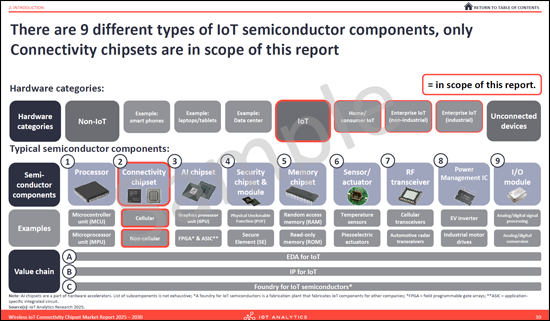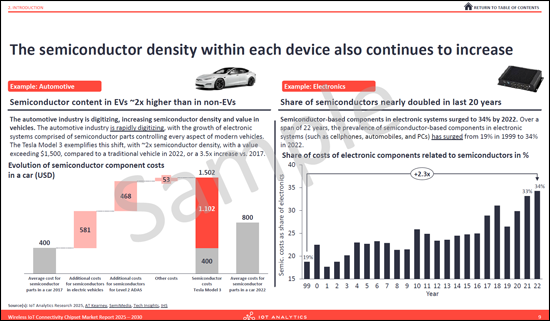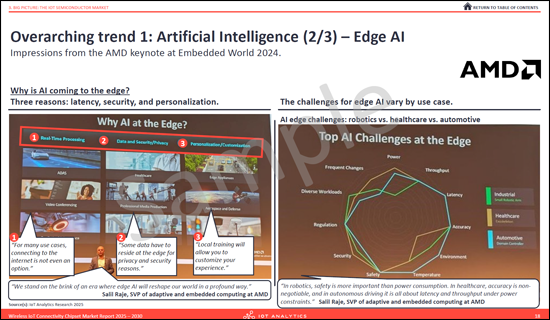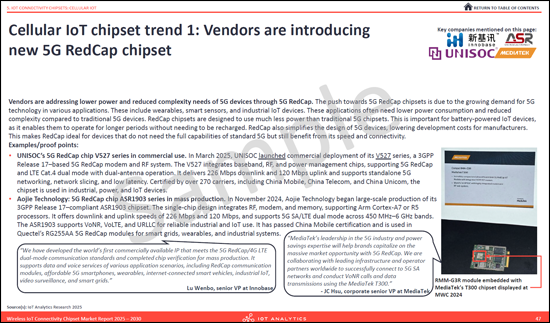|
市場調查報告書
商品編碼
1850610
無線物聯網連接晶片組市場:2025-2030Wireless IoT Connectivity Chipset Market Report 2025-2030 |
|||||||
本報告對無線物聯網連接晶片組市場進行了詳區隔析,涵蓋市場規模(支出、出貨量和平均售價)、廠商佔有率以及蜂窩、Wi-Fi、藍牙和非授權低功耗廣域網路(LPWA)等區隔市場的技術趨勢。
範例預覽



連網物聯網設備的數量逐年增加,每個設備所需的半導體價值也不斷上升。典型的物聯網設備包含多達九種不同的半導體組件,本報告重點在於實現無線通訊的連接晶片組。
本報告系統性地介紹了四個關鍵技術領域的市場規模和預測、競爭格局和技術趨勢:蜂窩物聯網、免許可低功耗廣域網路 (LPWA)、Wi-Fi 物聯網和藍牙物聯網。
該分析基於對晶片組供應商和終端用戶公司的訪談,並結合對重大行業事件的觀察和廣泛的二手研究。
範例預覽



報告概述
- 156頁報告: 提供五年預測無線物聯網連接晶片組市場
- 四大技術詳區隔析: 對蜂窩物聯網、Wi-Fi 物聯網、藍牙物聯網和非授權低功耗廣域網路 (LPWA) 進行結構化分析。
- 超過 12 項技術趨勢分析: 分析關鍵發展,包括 5G RedCap、LTE Cat-1 bis、能量收集和 Wi-Fi 7 的應用。
- 廠商佔有率分析: 提供蜂窩、Wi-Fi 和藍牙物聯網晶片組市場競爭格局的詳區隔析。
主要分析領域
- 物聯網半導體市場概述: 定義物聯網設備中使用的九種半導體組件,並計算整個物聯網半導體市場及其價值鏈(代工廠、EDA、IP 等)的規模。 本報告還概述了影響該行業的五大總體趨勢,包括人工智慧整合、硬體安全、地緣政治動態、國家戰略投資和供應鏈多元化。
- 物聯網連接技術概述 詳細介紹了 24 種主要的蜂窩和非蜂窩技術標準,包括傳統蜂窩、寬頻蜂窩和授權 LPWA 蜂窩,以及有線、WPAN、免授權 LPWA、WLAN 和衛星蜂窩。
- 蜂窩物聯網深度分析 分析了蜂窩物聯網晶片組市場(包括支出、出貨量和平均售價),並預測到 2030 年的發展趨勢。報告依技術、地區和垂直行業進行了區隔,並詳細介紹了五大關鍵趨勢,包括 5G RedCap 的採用和 LTE Cat-1 bis 的成長。
- 免授權 LPWA 深度分析 分析了免授權 LPWA 晶片組市場,涵蓋了依技術劃分的市場支出、出貨量和平均售價。本報告探討了四大關鍵趨勢,包括用於無電池設備的能量收集以及低功耗廣域網路 (LPWAN) 和衛星連接的融合。
- Wi-Fi 物聯網深度分析: 本報告分析了 Wi-Fi 物聯網晶片組市場,包括支出、出貨量和平均售價 (ASP),並依地區進行了區隔。報告中還涵蓋了競爭格局和關鍵趨勢,包括低功耗 Wi-Fi 模組和 Wi-Fi 7 的擴展。
- 藍牙物聯網深度分析: 本報告探討了藍牙物聯網晶片組市場,包括支出、出貨量和平均售價 (ASP),並依地區進行了區隔。報告還涵蓋了競爭格局以及為優化連接而採用 Wi-Fi 和藍牙雙模模組的趨勢。
公司列表
|
|
|
目錄
第一章:摘要整理
第二章:引言
第三章:概覽:物聯網半導體市場
- 章節概要:概覽 - 物聯網半導體市場
- 概述:物聯網半導體市場分為兩部分
- 第一部分:物聯網半導體元件 - 依類型劃分的支出
- 第二部分:擴展的物聯網半導體價值鏈 - 依價值鏈區隔劃分的支出
- 物聯網半導體市場的整體競爭格局市場
- 物聯網產業對半導體公司的重要性
- 影響物聯網半導體的五大整體趨勢
- 整體趨勢
- 近期新半導體晶圓廠建置公告
- 研究方法:物聯網相關業務概況-以台積電為例
第四章:物聯網連接晶片組:概述
- 章節概要:物聯網連結格局
- 物聯網連接晶片組:關鍵標準概述
- 物聯網連接晶片組:蜂窩網絡
- 物聯網連接晶片組:非蜂窩網路 - 有線
- 物聯網連接晶片組:非蜂窩網路 - 無線
- 全球半導體元件支出:物聯網連接晶片組與其他半導體元件的比較
- 全球物聯網連接晶片組市場支出
- 全球物聯網連接晶片組市場依技術劃分的支出
- 物聯網半導體市場整體競爭格局
- 主要公司簡介:高通
- 主要公司簡介:博通
第五章:物聯網連接晶片組:蜂窩物聯網
- 章節概述:物聯網連接晶片組 - 蜂巢物聯網
- 全球蜂窩物聯網晶片組支出 - 概述
- 分析師對蜂窩物聯網市場的評論
- 全球蜂窩物聯網晶片組支出 - 依技術劃分
- 全球蜂窩物聯網晶片組支出 - 依地區劃分
- 全球蜂窩物聯網晶片組支出 - 依垂直行業劃分
- 全球蜂窩物聯網晶片組出貨量 - 概述
- 全球蜂窩物聯網晶片組出貨量 - 依技術劃分
- 全球蜂窩物聯網晶片組出貨量 - 依地區劃分
- 全球蜂巢式物聯網晶片組出貨量 - 依垂直產業劃分
- 全球蜂窩物聯網晶片組平均售價 - 依地區劃分
- 蜂窩物聯網晶片組競爭格局:主要供應商市場佔有率(基於收入)
- 蜂窩物聯網晶片組競爭格局:過去與未來市場表現(基於收入)
- 蜂窩物聯網晶片組競爭格局:主要供應商市場佔有率(基於出貨量)
- 蜂窩物聯網晶片組競爭格局:過去與未來市場表現(基於出貨量)
- 蜂窩物聯網晶片組趨勢
第六章:物聯網連接晶片組:免授權低功耗廣域網路 (LPWA)
- 章節概述:物聯網連接晶片組 - 免授權低功耗廣域網路 (LPWA)
- 全球免授權低功耗廣域網路 (LPWA) 晶片組支出概覽
- 分析師評論免授權低功耗廣域網路 (LPWA) 市場
- 全球免授權 LPWA 晶片組支出 - 依技術劃分
- 全球免授權 LPWA 晶片組出貨量 - 概述
- 全球免授權 LPWA 晶片組出貨量 - 依技術劃分
- 全球免授權 LPWA 晶片組平均售價 - 依技術劃分
- 免授權 LPWA 晶片組發展趨勢
第七章:物聯網連接晶片組:Wi-Fi 物聯網
- 章節概述:物聯網連接晶片組 - Wi-Fi 物聯網
- 全球 Wi-Fi 物聯網晶片組支出 - 概述
- 全球 Wi-Fi 物聯網晶片組出貨量 - 概述
- 全球 Wi-Fi 物聯網晶片組平均售價 - 概述
- 分析師對 Wi-Fi 物聯網市場的評論
- 全球 Wi-Fi 物聯網晶片組支出 - 依技術劃分區域
- Wi-Fi 物聯網晶片組競爭格局:主要供應商的市場佔有率(基於收入)
- Wi-Fi 物聯網晶片組競爭格局:過去與未來的市場表現(基於收入)
- Wi-Fi 物聯網晶片組物聯網趨勢
第八章:物聯網連接晶片組:藍牙物聯網
- 章節概要:物聯網連接晶片組 - 藍牙物聯網
- 全球藍牙物聯網晶片組支出概覽
- 全球藍牙物聯網晶片組出貨量概覽
- 全球藍牙物聯網晶片組平均售價概覽
- 分析師對藍牙物聯網市場的評論
- 全球藍牙物聯網晶片組支出 - 依地區劃分
- 藍牙物聯網晶片組競爭格局:主要供應商的市場佔有率(基於收入)
- 藍牙物聯網晶片組競爭格局:過去與未來的市場表現(基於收入)
- 藍牙物聯網晶片組趨勢
第九章:研究方法與市場定義
第十章:物聯網分析概論
A 156-page report on the wireless IoT chipset market with forecast. Details market sizing (spending, shipments, ASP), vendor shares, and technology trends across cellular, Wi-Fi, Bluetooth, and unlicensed LPWA segments.
Sample preview



The number of connected IoT devices continues to grow, with rising semiconductor value per device. Each IoT device typically contains up to nine semiconductor components. This report focuses on connectivity chipsets, which enable wireless communication across cellular and non-cellular networks.
This report provides an in-depth analysis of the wireless IoT connectivity chipset market, focusing on four core technology segments: Cellular IoT, Unlicensed LPWA, Wi-Fi IoT, and Bluetooth IoT. It offers a structured view of market size and forecast, competitive dynamics, and the key technology developments shaping each segment.
The analysis is grounded in primary research, including interviews with experts from chipset vendors and end-user organizations. These insights are supported by extensive secondary research and observations from major industry trade events.
Sample preview



Report at a glance:
- 156-page report: Detailing the wireless IoT connectivity chipset market with a 5-year forecast.
- 4 technology deep dives: A structured analysis of Cellular IoT, Wi-Fi IoT, Bluetooth IoT, and Unlicensed LPWA.
- 12+ technology trends analyzed: Examination of key developments, including 5G RedCap, LTE Cat-1 bis, energy harvesting, and Wi-Fi 7 adoption.
- Vendor market share analysis: A breakdown of the competitive landscape for cellular, Wi-Fi, and Bluetooth IoT chipset markets.
Key areas of analysis:
- IoT semiconductor market overview: Defines nine types of IoT semiconductor components and sizes the general IoT semiconductor market and its enhanced value chain (foundries, EDA, IP). It also outlines five overarching trends impacting the industry: AI integration, hardware security, geopolitical dynamics, strategic national investments, and supply chain diversification.
- IoT connectivity technology overview: Details 24 main standards across cellular and non-cellular technologies, including legacy, broadband, and licensed LPWA for cellular, and wired, WPAN, unlicensed LPWA, WLAN, and satellite for non-cellular.
- Cellular IoT deep dive: Analyzes the market for cellular IoT chipsets, including spending, shipments, and average selling price (ASP), with forecasts to 2030. It provides breakdowns by technology, region, and industry vertical and details five key trends, such as the introduction of 5G RedCap and the growth of LTE Cat-1 bis
- Unlicensed LPWA deep dive: Examines the market for unlicensed LPWA chipsets, covering market spending, shipments, and ASP by technology. It discusses four key trends, including energy harvesting for battery-free devices and the convergence of LPWAN and satellite connectivity.
- Wi-Fi IoT deep dive: Details the market for Wi-Fi IoT chipsets, with analysis of spending, shipments, and ASP, alongside a regional breakdown. The competitive landscape is outlined, as are key trends such as low-power Wi-Fi modules and the expansion of Wi-Fi 7.
- Bluetooth IoT deep dive: Presents an analysis of the Bluetooth IoT chipset market, including spending, shipments, and ASP, with a regional breakdown. It covers the competitive landscape and the trend toward dual-mode Wi-Fi & Bluetooth modules for optimized connectivity.
A data-driven foundation for key business functions:
- Strategy & corporate development: Inform long-term strategy with market forecasts, regional growth analysis, and insights into the five overarching trends shaping the semiconductor industry, from geopolitics to supply chain diversification.
- Product management & marketing: Shape product roadmaps with detailed analysis of technology adoption (e.g., 5G RedCap vs. LTE Cat-1 bis), competitive landscapes for each connectivity segment, and emerging use cases driven by new standards.
- R&D & engineering leadership: Direct technical priorities with insights into key trends like low-power chipset design, multi-protocol integration.
- Market intelligence & competitive analysis: Benchmark company performance with granular market share data for cellular IoT, Wi-Fi IoT, and Bluetooth IoT chipsets, alongside profiles of key vendors' product portfolios and R&D focus areas.
Key concepts defined:
- IoT semiconductor: Specialized semiconductor-based components that provide the core functionality and connectivity of IoT devices, including processing, communication, sensing/actuating, power management, and security. The report categorizes these components based on their intended use at the "design stage" of a product's life cycle.
- IoT connectivity chipset: An IoT connectivity chipset is a radio SoC or baseband transceiver embedded in an IoT device, either directly or via a communication module, that enables and manages wired or wireless connectivity. It supports communication over technologies such as cellular (2G-5G, NB-IoT, LTE-M), Wi-Fi, Bluetooth, Zigbee, Thread, LoRa, or Ethernet, allowing the device to connect and exchange data within the IoT ecosystem.
- Cellular IoT chipset: A cellular IoT chipset is a radio SoC or a baseband/transceiver solution embedded in an IoT device, either directly or via a communication module, that enables and manages connectivity over licensed cellular networks. It supports technologies such as 2G, 3G, 4G (LTE, LTE-M, NB-IoT, Cat-1 bis) and 5G (RedCap, eRedCap) to facilitate wide-area IoT communication.
- Wi-Fi IoT chipset: A Wi-Fi IoT chipset is a radio SoC or a transceiver embedded in an IoT device, either directly or via a module, that enables wireless local-area connectivity using Wi-Fi standards such as Wi-Fi 4, 5, 6, 6E, 7, or 802.11ah (HaLow).
- Bluetooth IoT chipset: A Bluetooth IoT chipset is a radio SoC or a transceiver solution embedded in an IoT device, either directly or through a module, that provides short-range wireless communication based on Bluetooth Classic, Bluetooth Low Energy (BLE), or Bluetooth Mesh standards for applications such as lighting and building controls. It excludes chipsets primarily used for consumer audio applications.
- Unlicensed LPWA chipset: An unlicensed LPWA (Low-Power Wide-Area) chipset is a radio SoC or a transceiver solution embedded in an IoT device, either directly or via a module, that enables long-range, low-power connectivity over unlicensed spectrum technologies such as LoRa, LoRaWAN, or mioty. It supports both public and private network deployments and is designed for IoT applications requiring low data throughput, extended battery life, and wide coverage.
Questions answered:
- What are wireless IoT connectivity chipsets, and how are they classified? (i.e., definition and types of IoT connectivity chipsets)
- What does the competitive landscape for wireless IoT connectivity chipsets look like?
- What are the market shares of leading vendors across cellular IoT, Wi-Fi IoT, and Bluetooth IoT segments?
- What is the current and forecasted market size for the cellular IoT, Wi-Fi IoT, Bluetooth IoT, and unlicensed LPWA market?
- What regional dynamics shape the wireless IoT connectivity market?
- What are the emerging trends in the wireless IoT connectivity market?
Companies mentioned:
A selection of companies mentioned in the report.
|
|
|
Table of Contents
1. Executive summary
2. Introduction
- 1. Chapter overview: Introduction
- 2. Starting point: The number of IoT connected devices continues to grow
- 3. The semiconductor density within each device also continues to increase
- 4. There are 9 different types of IoT semiconductor components, only Connectivity chipsets are in scope of this report
- 5. Definitions (1/6): Semiconductors & IoT semiconductors
- 6. Definitions (2/6): Processors
- 7. Definitions (3/6): Connectivity chipsets
- 8. Definitions (4/6): AI chipsets
- 9. Definitions (5/6): Security chipsets
- 10. Definitions (6/6): Other key components
3. Big picture: The IoT semiconductor market
- 1. Chapter overview: Big picture - The IoT semiconductor market
- 2. Overview: The general IoT semiconductor market is split into 2 parts
- 3. Part 1: IoT semiconductor components - Spending by type
- 4. Part 2: Enhanced IoT semiconductor value chain - Spending by value chain segment
- 5. Overall IoT semiconductor competitive landscape
- 6. Importance of IoT as a segment within several chip companies
- 7. 5 overarching trends impacting IoT semiconductors
- 8. Overarching trend 1 (3 parts)
- 9. Overarching trend 2
- 10. Overarching trend 3 (2 parts)
- 11. Overarching trend 4 (4 parts)
- 12. Overarching trend 5 (2 parts)
- 13. Recent announcements for new semiconductor plants
- 14. Methodology: Mapping IoT-related business - TSMC
4. IoT connectivity chipsets: Overview
- 1. Chapter overview: IoT connectivity: Overview
- 2. IoT connectivity chipsets: Overview of the main standards
- 3. IoT connectivity chipsets: Cellular (6 parts)
- 4. IoT connectivity chipsets: Non-cellular - Wired (2 parts)
- 5. IoT connectivity chipsets: Non-cellular - Wireless (6 parts)
- 6. Global semiconductor component spending: IoT connectivity chipsets vs other semiconductor components (2020-2030)
- 7. Global IoT connectivity chipset market spending
- 8. Global IoT connectivity chipset market spending by technology
- 9. Overall IoT semiconductor competitive landscape
- 10. Key company profile: Qualcomm (6 parts)
- 11. Key company profile: Broadcom (3 parts)
5. IoT connectivity chipsets: Cellular IoT
- 1. Chapter overview: IoT connectivity chipsets: Cellular IoT
- 2. Global cellular IoT chipset spending 2020-2030-Overview
- 3. Analyst commentary on the cellular IoT market
- 4. Global cellular IoT chipset spending 2020-2030-By technology
- 5. Global cellular IoT chipset spending 2020-2030-By region
- 6. Global cellular IoT chipset spending 2020-2030-By industry vertical
- 7. Global cellular IoT chipset shipments 2020-2030-Overview
- 8. Global cellular IoT chipset shipments 2020-2030-By technology
- 9. Global cellular IoT chipset shipments 2020-2030-By region
- 10. Global cellular IoT chipset shipments 2020-2030-By industry vertical
- 11. Global cellular IoT chipset ASP 2020-2030-By region
- 12. Cellular IoT chipsets competitive landscape (1/4): Market share of key vendors (based on revenue)
- 13. Cellular IoT chipsets competitive landscape (2/4): Historical and expected market performance (based on revenue)
- 14. Cellular IoT chipsets competitive landscape (3/4): Market share of key vendors (based on shipments)
- 15. Cellular IoT chipsets competitive landscape (4/4): Historical and expected market performance (based on shipments)
- 16. Cellular IoT chipset trend 1
- 17. Cellular IoT chipset trend 2
- 18. Cellular IoT chipset trend 3
- 19. Cellular IoT chipset trend 4
- 20. Cellular IoT chipset trend 5 (2 parts)
6. IoT connectivity chipsets: Unlicensed LPWA
- 1. Chapter overview: IoT connectivity chipsets: Unlicensed LPWA
- 2. Global unlicensed LPWA chipset spending 2020-2030-Overview
- 3. Analyst commentary on the unlicensed LPWA market
- 4. Global unlicensed LPWA chipset spending 2020-2030-By technology
- 5. Global unlicensed LPWA chipset shipments 2020-2030-Overview
- 6. Global unlicensed LPWA chipset shipments 2020-2030-By technology
- 7. Global unlicensed LPWA chipset ASP 2020-2030-By technology
- 8. Unlicensed LPWA chipset trend 1
- 9. Unlicensed LPWA chipset trend 2
- 10. Unlicensed LPWA chipset trend 3
- 11. Unlicensed LPWA chipset trend 4
7. IoT connectivity chipsets: Wi-Fi IoT
- 1. Chapter overview: IoT connectivity chipsets: Wi-Fi IoT
- 2. Global Wi-Fi IoT chipset spending 2020-2030-Overview
- 3. Global Wi-Fi IoT chipset shipments 2020-2030-Overview
- 4. Global Wi-Fi IoT chipset ASP 2020-2030-Overview
- 5. Analyst commentary on the Wi-Fi IoT market
- 6. Global Wi-Fi IoT chipset spending 2020-2030-By region
- 7. Wi-Fi IoT chipsets competitive landscape (1/2): Market share of key vendors (based on revenues)
- 8. Wi-Fi IoT chipsets competitive landscape (2/2): Historical and expected market performance (based on revenues)
- 9. Wi-Fi IoT chipset trend 1
- 10. Wi-Fi IoT chipset trend 2
8. IoT connectivity chipsets: Bluetooth IoT
- 1. Chapter overview: IoT connectivity chipsets: Bluetooth IoT
- 2. Global Bluetooth IoT chipset spending 2020-2030-Overview
- 3. Global Bluetooth IoT chipset shipments 2020-2030-Overview
- 4. Global Bluetooth IoT chipset ASP 2020-2030-Overview
- 5. Analyst commentary on the Bluetooth IoT market
- 6. Global Bluetooth IoT chipset spending 2020-2030-By region
- 7. Bluetooth IoT chipsets competitive landscape (1/2): Market share of key vendors (based on revenues)
- 8. Bluetooth IoT chipsets competitive landscape (2/2): Historical and expected market performance (based on revenues)
- 9. Bluetooth IoT chipset trend 1
9. Methodology & market definitions
- 1. Market category definitions (2 parts)
- 2. Other definitions (2 parts)
- 3. Country mappings to regions (3 parts)
- 4. Research Methodology
- 5. Methodology: How individual companies were analyzed
10. About IoT Analytics
- 1. About IoT Analytics
- 2. Other publications by IoT Analytics
- 3. Information and contact










